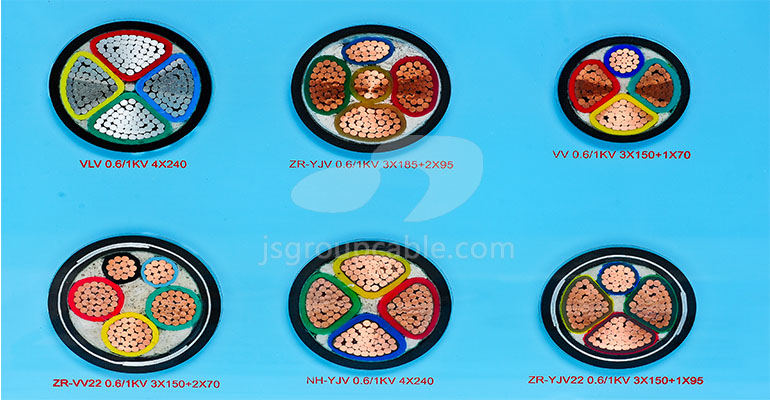- Offices Time:24 Hours Online
- Email:[email protected]
- WhatsApp:+8618339938759

Posted on November 4, 2022
The difference between high voltage cable and low voltage cable
The main difference between high-voltage cables and low-voltage cables is the difference in structure. High-voltage cables have semiconductor layers and shielding layers, while low-voltage cables do not. Therefore, the insulation layer of high-voltage cables is much thicker than that of low-voltage cables, and the structure is complex and the process requirements are also high.
1.Semiconductor layer
The main function of the inner semiconductor layer is to improve the electric field effect, and its function is to avoid partial discharge between the insulating layer and the metal sheath.
2.Shielding layer
There are three main functions of the high-voltage cable shielding layer:
(1) Shielding the electric field
Since it is a shielding layer, it acts as a shield. The voltage in the high-voltage cable is very high, and the electric field it generates is very strong. The shielding layer can effectively prevent the high-voltage cable from interfering with the outside world.
(2) The current through the capacitor during operation
The innermost layer of the high-voltage line is the conductor, with an insulating layer in the middle and a metal sheath on the outside. The two conductors are separated by an insulating layer, which can be thought of as a capacitor. The alternating current will charge and discharge the capacitor, so the shielding layer can provide a loop for charging and discharging the capacitor.
In addition, both the metal shielding layer and the metal armor of the high-voltage cable need to be grounded at one end.
(3) Can be used as a short-circuit current channel
When the insulation of the high-voltage cable is damaged, if there is no shielding layer, the cable will leak to the ground, which is a safety hazard.

3.How to distinguish between low-voltage cables and high-voltage cables
(1) Purpose
High-voltage cables are mainly used by the power sector to transmit power and change the voltage level of substations. Our common voltage levels are below 220KV, and the voltage levels of long-distance transmission power are all ultra-high voltages, which are designated by the power department for special electric workers for construction and maintenance. Low-voltage cables are suitable for electrical equipment with withstand voltages below 450V/750V, and are widely used and classified. General industrial plastic insulated cables are used for fixed laying; rubber sheathed low-voltage insulated cables for mobile use; building installations are mainly used for the laying of the main power circuit, branches and branches, and special flat elevator cables for elevator installation.
(2) erection situation
When the high and low voltage lines are erected separately, the erection distance between the high voltage line poles is larger, and the poles are higher.
(3) View the structure
There are many layers of high-voltage cables, including conductors, insulating layers, inner sheaths, fillers, and outer insulation from inside to outside; low-voltage cables from inside to outside are: conductors, insulating layers, steel strips, and sheaths. High-voltage cables have more semiconductor layers and shielding layers than low-voltage cables. Therefore, the insulation layer of high-voltage cables is much thicker than that of low-voltage cables, and the structure is complex and the process requirements are also high.
(4) View parameters
The outermost layer of the cable will print the relevant parameters of the cable, including length, rated voltage, cable type, cross-sectional area, etc., which is the most intuitive and accurate identification method.
(5) View the section
The innermost part of the cable is the conductive core, and the outermost are: insulating layer, semi-conductive layer, shielding layer, filling layer, steel protective layer, and rubber protective layer.
(6) Check the thickness of the insulating layer
The insulation layer of high-voltage cables is relatively thick, and the insulation layer of low-voltage cables is relatively thin. The insulation layer of low-voltage cables is generally within 3 mm, and the insulation layer of high-voltage cables is generally more than 5 mm. The high-voltage cable has an insulating layer after removing the outer skin, which is the main insulating layer that is wrapped outside the cable core and is white like plastic. The low-voltage cable does not have this main insulating layer, but only a rubber protective layer.
(7) Production process
Low-voltage cables can be produced using ordinary polyvinyl chloride and cross-linked polyethylene. There are two types of low-voltage cables: ordinary and cross-linked. Medium and high voltage cables are only cross-linked cables, and 6kV-35kV are produced by three-layer co-extrusion and high-density cross-linked polyethylene.
High-voltage cables can only be used after the cable heads are made according to strict manufacturing processes, while low-voltage cables are not required to make cable heads. In addition, the laying requirements of high-voltage cables and low-voltage cables are also different.
Therefore, in the use of cables, we must consider suitable cables according to various factors, understand the application of high-voltage cables and application scenarios of low-voltage cables, and choose products that are suitable for us. Jinshui Wire&Cable Group provides customers with safe and secure cables product.
Post categories
Most Popular Posts
-
The 136th Canton Fair welcomes you to participate!
October 12, 2024 -
High temperature cable introduction
July 26, 2024 -
Kenya Power and Energy Exhibition 2024
June 11, 2024 -
Introduction of rubber sheathed cable
June 5, 2024





